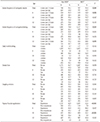1. Health Insurance Review & Assessment Service. 2016 Statistics of Healthcare expenses: 17. Healthcare service reimbursement by the ranking of multi-frequency occurring diseases according to the list of three-character categories of Korea Standard Classification of Diseases: out-patients. Seoul: Ministry of health & Wealfare;2016. p. 59–62.
2. Lee SK, Lee KW, Chang KW. Reasons for extracted permanent teeth in Korean population. J Korean Acad Oral Health. 2001; 25:139–163.
3. Kim JB, Choi EG, Moon HS, Kim JB, Kim DK, Lee HS, et al. Prevention of dental caries. In : Kim JB, Choi EG, Moon HS, Kim JB, Kim DK, Lee HS, editors. Public health dentistry. 5th ed. Seoul: Komoonsa;2009. p. 65–105.
4. Ju HJ, Lee HS, Oh HW. Relationship of oral health literacy with oral health behaviors among adults. J Korean Acad Oral Health. 2015; 39:186–194.

5. Harris NO. Introduction to primary preventive dentistry. In : Harris NO, Garcia-Godoy F, editors. Primary preventive dentistry. 6th ed. New Jersey: Pearson Education Inc.;2004. p. 1–22.
6. Kim SC, Lee SM, Kim JY, Kim JB. Caries preventive effects of a fissure sealant program in Habchon-gun, Korea. J Korean Acad Oral Health. 2003; 27:471–486.
7. Song GB, Choi YH, Hong SJ, Kim JB. Dental caries prevalence in relation to socioeconomic factors and dental health behaviors among Korean adults. J Korean Acad Oral Health. 2003; 27:319–328.
8. Kim HY. Evaluation of effects of health behaviors and dental service use on the association between socioeconomic status and unmet dental treatment needs. J Korean Acad Oral Health. 2006; 30:85–94.
9. Jung SH, Tsakos G, Sheiham A, Ryu JI, Watt RG. Socio-economic status and oral health-related behaviours in Korean adolescents. Soc Sci Med. 2010; 70:1780–1788.

10. Boyce W, Torsheim T, Currie C, Zambon A. The family affluence scale as a measure of national wealth: validation of an adolescent self-report measure. Soc Indic Res. 2006; 78:473–487.

11. Kim HN, Kim JH, Kim SY, Kim JB. Associations of Community Water Fluoridation with Caries Prevalence and Oral Health Inequality in Children. Int J Environ Res Public Health. 2017; 14:631.

12. Park YG, Kim BJ, Han DH, Bae KH, Lee KH, Kim JB. Evaluation of caries prevention effect from pit and fissure sealant program added by community water fluoridation program in Habchon-Up, Habcheon-Gun, Korea. J Korean Acad Oral Health. 2008; 32:517–527.
13. Cho MS, Han KT, Park S, Moon KT, Park EC. The differences in healthcare utilization for dental caries based on the implementation of water fluoridation in South Korea. BMC Oral Health. 2016; 16:119.

15. Ministry of Health and Welfare. 2016 Guide for comprehensive health promotion program (Oral health). Current status of water fluoridation program. Seoul: Ministry of Health and Welfare;2015. p. 79.
18. Statistical Information System of Changwon-si. Resident registration demographics on September 2015. cited 2015 Sep 8. Available from:
http://stat.changwon.go.kr.
19. Gyeongsangnamdo Office of Education. 2014 Annual educational statistics. Tables of school status. cited 2015 March 08. Available from:
http://stats.gne.go.kr.
20. Shin BM, Jung SH. Socio-economic inequalities in the self-rated oral health status of South Koreans. J Korean Acad Oral Health. 2012; 36:219–227.
21. World Health Organization. Oral Health Surveys. 4th ed. Geneva: World Health Organization;1997. p. 21–52.
22. Choi JS, Park DY, Jung SH. The relationship between pit and fissure sealant (PFS) experience and the socio-economic factors of adolescents before and after coverage by National Health Insurance (NHI). J Korean Acad Oral Health. 2017; 41:116–121.

23. Yaacob M, Worthington HV, Deacon SA, Deery C, Walmsley AD, Robinson PG, et al. Powered versus manual toothbrushing for oral health. Cochrane Database Syst Rev. 2014; 17(6):CD002281.

24. Choi YS, Lee JS, Rhyu YJ. Comparative study aspects of oral health between rural and urban children with special reference dental caries. J Korean Soc Sch Health. 1992; 5:101–110.
25. Clarkson J, McLoughlin J, O'Hickey S. Water fluoridation in Ireland: a success story. J Dent Res. 2003; 82:334–337.
26. Do L, Ha D, Peres MA, Skinner J, Byun R, Spencer AJ. Effectiveness of water fluoridation in the prevention of dental caries across adult age groups. Community Dent Oral Epidemiol. 2017; 45:225–232.

27. Kim JB, Paik DI, Moon HS, Song Yeon H, Park DY, Jung SH. Effect of water fluoridation on dental caries prevention in 11-year-old Korean children. J Korean Acad Oral Health. 1997; 21:583–592.
28. Lee HS, Chang KW, Kim JB, Kim DK, Kim KS, Park DY. The effectiveness of community water fluoridation. Seoul: Korea Health Promotion Foundation;2011. p. 100–104.
29. Do LG, Ha DH, Spencer AJ. Factors attributable for the prevalence of dental caries in Queensland children. Community Dent Oral Epidemiol. 2015; 43:397–405.

30. Cho HJ, Lee HS, Paik DI, Bae KH. Association of dental caries with socioeconomic status in relation to different water fluoridation levels. Community Dent Oral Epidemiol. 2014; 42:536–542.










 PDF
PDF ePub
ePub Citation
Citation Print
Print





 XML Download
XML Download